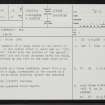Carmont Hill
Cairn (Prehistoric), Marker Cairn (Post Medieval)
Site Name Carmont Hill
Classification Cairn (Prehistoric), Marker Cairn (Post Medieval)
Canmore ID 37024
Site Number NO88SW 16
NGR NO 80670 83549
Datum OSGB36 - NGR
Permalink http://canmore.org.uk/site/37024
- Council Aberdeenshire
- Parish Dunnottar
- Former Region Grampian
- Former District Kincardine And Deeside
- Former County Kincardineshire
NO88SW 16 8067 8354.
(NO 8067 8354) Cairn (NR)
OS 1:10,000 map, (1974)
There are the remains of a large cairn on the summit of Carmont Hill. It was opened about 12 years ago (c. 1852) and a short cist 'level with the surface of the ground', containing a small urn and black unctuous earth was found. The cist was covered up and left in the same state as it was found.
Name Book 1864.
The cairn survives as a stony platform, about 16.5m in diameter and 0.8m high, surmounted in the centre by a modern marker cairn which probably covers the reburied cist.
Revised at 1:2500.
Visited by OS (R L) 4 December 1969.
Field Visit (March 1982)
Carmant Hill NO 806 835 NO88SW 16
This cairn is situated on the summit of Carmant Hill and measures 16m in diameter; it has been reduced by robbing to a height of no more than 0.8m, and a modern cairn has been built on top. About 1852 excavation revealed a cist 'level with the surface of the ground'; it contained a 'small urn'.
RCAHMS 1982, visited March 1982
(Name Book, Kincardine, No. 6, p. 24)
Field Visit (December 2000)
The remains of a cairn are situated on the summit of Carmont Hill. The cairn survives as a stony platform measuring 16.5m in diameter and is 0.7m high. A modern conical marker cairn in the centre of the cairn probably covers a cist which had been exposed in 1852.
Magnar Dalland and Stuart Halliday (Headland Archaeology) December 2000; NMRS MS 1039/65, no.8








